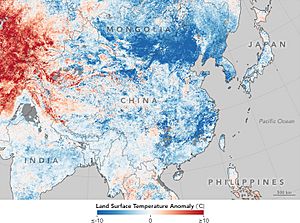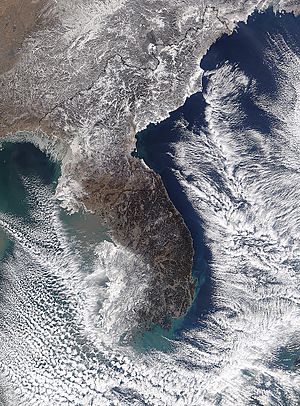January 2016 East Asia cold wave facts for kids

Variation from average land surface temperatures between 17–24 January 2016
|
|
| Formed | 22 January 2016 |
|---|---|
| Dissipated | 24 January 2016 |
| Lowest temperature | −46.8 °C (−52.2 °F) in Inner Mongolia, −19 °C (−2 °F) in Pyongyang (lowest urban temperature) |
| Maximum snowfall or ice accretion | 142 cm (56 in) in Kitahiroshima, Japan |
| Total fatalities | At least 109 deaths |
| Areas affected | East Asia, Southeast Asia and South Asia |
In late January 2016, a very strong cold wave hit a large part of East Asia. It also reached parts of Southeast Asia and northern South Asia. This cold wave brought record low temperatures and a lot of snow to many places.
For the first time ever, sleet was seen in Okinawa, Japan. Many other areas experienced their coldest temperatures in decades. The heavy snow and freezing weather caused thousands of people to get stuck in four different countries. Sadly, at least 109 people died because of the extreme cold. This event happened because the Arctic got warmer very quickly, which changed how the Arctic oscillation worked.
Contents
Hong Kong's Big Freeze
On January 24, 2016, the temperature at the Hong Kong Observatory dropped to its lowest in 59 years. Hundreds of people went hiking up Tai Mo Shan to see the rare cold weather. Temperatures there fell to a record low.
Many people were also on Tai Mo Shan for a 100-kilometer marathon. Because of the cold, 129 people needed to be rescued, and 67 were taken to the hospital with hypothermia. This is when your body loses heat faster than it can make it.
The Hong Kong Fire Services Department (FSD) sent out many fire trucks, ambulances, and over 300 staff to help. The Government Flying Service even used helicopters to rescue eight patients. The FSD also responded to many calls for help at Kowloon Peak. The Civil Aid Service and Hong Kong Police Force also joined in the rescue efforts.
Classes were cancelled for more than 510,000 students on January 25. This included kindergartens, primary schools, and the English Schools Foundation. It was believed to be the first time the Education Bureau had ever cancelled classes because of cold weather. School officials said it was important to cancel classes because icy roads could be dangerous for school buses. Buses in Hong Kong do not usually have special winter tires.
Japan's Record Snow and Cold
Snowstorms across Japan caused six deaths and injured 100 other people. More than 600 flights were cancelled or delayed across the country.
Okinawa saw sleet for the first time since records began. Amami Ōshima had snow for the first time in 115 years! Many parts of mainland Japan were covered in record amounts of snow. Temperatures in Tokyo dropped to their lowest since 1984. Across western Japan, many cities also saw their coldest temperatures ever recorded.
Mainland China's Rare Snowfall
Parts of Guangzhou reported snow and sleet. This was very unusual, as snow had not been seen there since 1967, and sleet since 1956. Snow also fell on Shenzhen, which is a very rare event for that area.
Farther north, the lowest temperature in Shanghai dropped sharply, and light snow fell on January 23. Twenty-four weather stations in China recorded their all-time lowest temperatures. Temperatures across Inner Mongolia also fell to a record low.
Korean Peninsula's Flight Chaos
Heavy snow and cold weather caused about 1,200 flights to be cancelled on Jeju-do, an island off the southwestern tip of the Korean Peninsula. This left about 90,300 passengers stranded. Ulleungdo island was completely covered in snow.
Temperatures in Seoul, the capital city, dropped to their lowest in 15 years. Many cities across the south of the country also broke their all-time low temperature records. In North Korea, about 40,000 construction workers were reportedly pulled from their building sites because of the cold.
Taiwan's Unexpected Freeze

A rush of cold air during the weekend of January 22–24 brought temperatures as low as 4 °C (39 °F) to Taipei. These were the lowest temperatures in 44 years for the city. Because Taiwan has a subtropical climate, many homes do not have central heating or good insulation. This made it very hard for people to stay warm.
Sadly, at least 85 people in Taiwan died due to the extreme cold. Most of these deaths happened in people's homes. The cold weather also caused a lot of damage to crops. President Ma Ying-jeou said that the crop damage was a serious national problem.
Cold Snap in South and Southeast Asia
When temperatures in Bangkok, Thailand dropped, 14 people across Thailand died. Many of them were already suffering from health problems. In Hanoi, Vietnam, the lowest temperature recorded was the coldest the city had seen in over 20 years. Snow even fell across the mountains of Lào Cai Province in northern Vietnam.
In Laos, temperatures in Houaphanh Province fell sharply. Some high-up areas even had frost, which caused several buffaloes to die in Xam Neua District. In the northern islands of the Philippines, temperatures dropped to 9 °C (48 °F). This was the coldest temperature recorded there in 2016.
In northern India, temperatures dropped to −16.6 °C (2.1 °F) in some areas. In New Delhi, temperatures fell below 5 °C (41 °F). Thick Fog caused by the low temperatures led to delays at Indira Gandhi International Airport. It also forced train services in New Delhi to be cancelled.
In Nepal, 700 schools were closed in Rautahat and Parsa because of thick fog and the cold. More people also went to medical facilities across the country because of cold-related illnesses.
Images for kids
See also
 In Spanish: Ola de frío en Asia Oriental de enero de 2016 para niños
In Spanish: Ola de frío en Asia Oriental de enero de 2016 para niños








